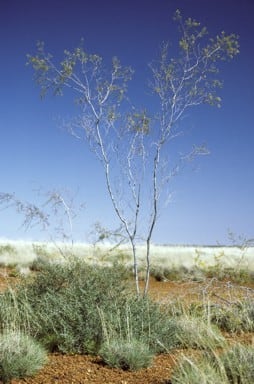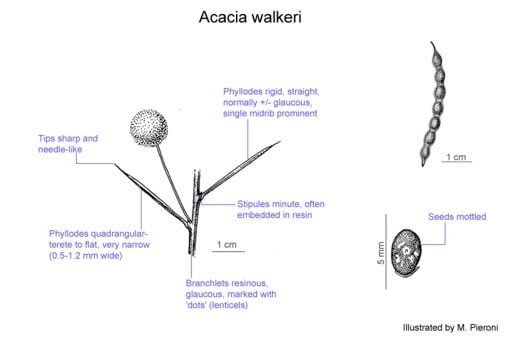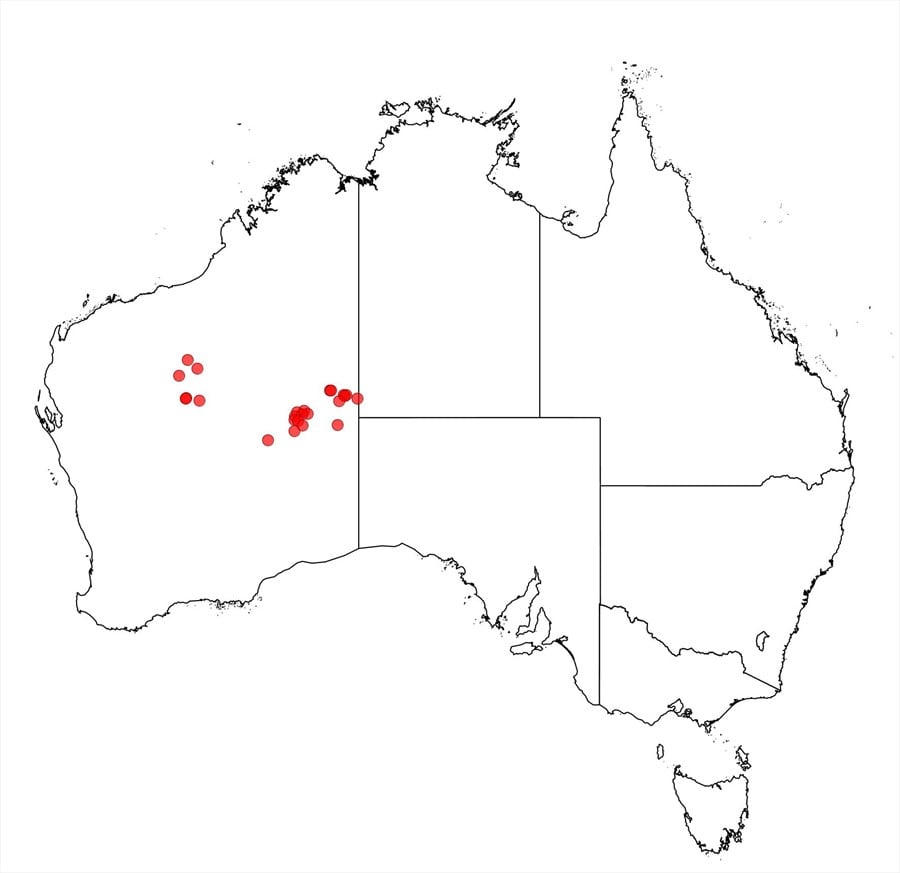Acacia walkeri Maslin
WATTLE
Acacias of Australia
Common Name
Walker’s Wattle
Family
Fabaceae
Distribution
Occurs in arid areas of W.A. where it extends from the western edge of the Little Sandy Desert and Pilbara regions E to the Central Ranges near the N.T. and S.A. borders.
Description
Spindly shrub (1–) 2–2.5 (–3.5) m high. Branchlets light brown to red, lenticellular, glabrous, resinous-viscid, scarred where phyllodes have fallen. Stipules persistent, 0.5–1 mm long, erect, often enveloped in resin. Phyllodes patent to ±inclined, acicular, quadrangular-terete to flat, (8–) 10–20 (–30) mm long, 0.5–1.2 mm wide, l:w = 30, pungent with a slender cusp, rigid, normally subglaucous to ±glaucous; 4-nerved when quadrangular-terete, 1-nerved per face when flat. Inflorescences simple, 1 or 2 per axil; peduncles 10–15 (–20) mm long, exceeding phyllodes, slender; heads globular, 5–6 mm diam. (fresh), 40–60 flowers, golden. Flowers 5-merous; sepals free, linear-spathulate. Pods submoniliform, (20–) 30–50 mm long, 3 mm wide, firmly chartaceous to thinly coriaceous. Seeds longitudinal, oblong to oblong-elliptic, 3–3.5 mm long, dark brown to ±black, mottled cream and cream on periphery and bordering pleurogram, exarillate.
Habitat
Grows in sandy loam or clay on plains or rocky slopes with other shrubs and spinifex ground cover.
Specimens
W.A.: 35 km from Old Mary Mia, on N edge of Miss Fairbairn Hills, SW edge of Little Sandy Desert, D.J.Edinger Nats 2 (PERTH); entrance to Glen Cumming, Rawlinson Ra., A.S.George 8850 (AD, NSW, PERTH); Gibson Desert, 140.5 km by road SE of Mt Everard on ‘Heather Highway’, B.R.Maslin 5661 (CANB, K, PERTH, distributed as A. maitlandii).
Notes
Acacia walkeri was noted as the first variant under A. maitlandii by B.R.Maslin in Fl. Australia 11A: 388 (2001).
Most closely related to and may possibly be better treated as an infraspecific taxon of A. maitlandii which differs in its broader, differently shaped, green and consistently flat phyllodes, larger flower heads and normally broader pods. Possibly confused with A. tetragonophylla which differs most obviously in its 5-nerved phyllodes that are clustered at mature nodes (single on new shoots), and larger, curved to coiled pods with seeds encircled by a bright orange-red or yellow aril.
FOA Reference
Flora of Australia Project
Author
J.Reid, B.R.Maslin
This identification key and fact sheets are available as a mobile application:
URL: https://apps.lucidcentral.org/wattle/
© Copyright 2018. All rights reserved.













